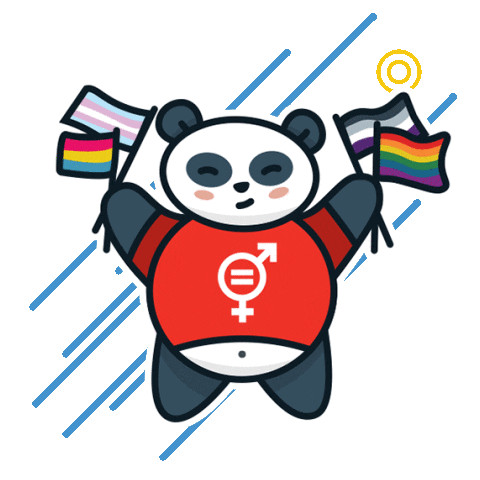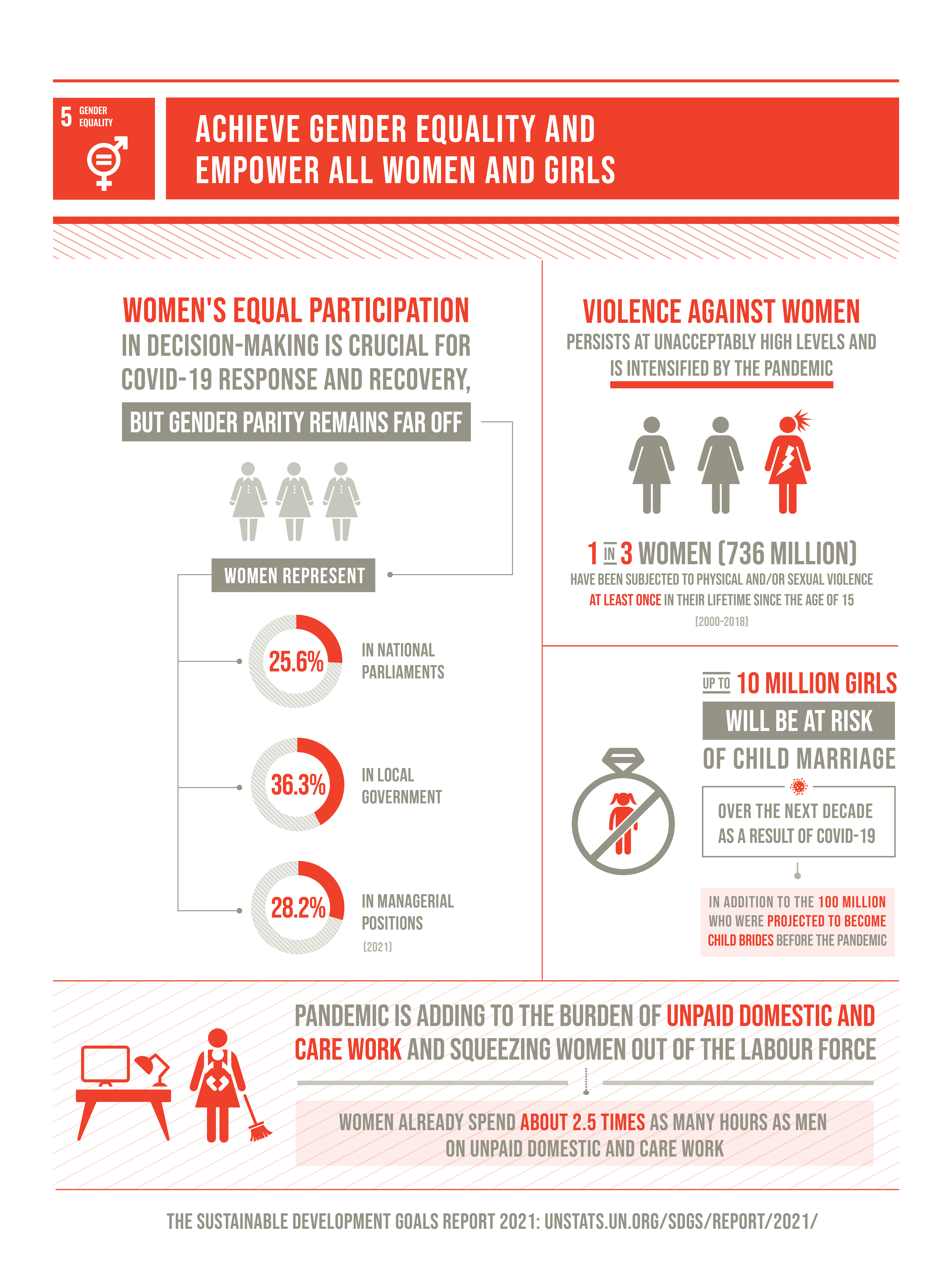



There has been progress over the last decades: More girls are going to school, fewer girls are forced into early marriage, more women are serving in parliament and positions of leadership, and laws are being reformed to advance gender equality.
Despite these gains, many challenges remain: discriminatory laws and social norms remain pervasive, women continue to be underrepresented at all levels of political leadership, and 1 in 5 women and girls between the ages of 15 and 49 report experiencing physical or sexual violence by an intimate partner within a 12-month period.
The effects of the COVID-19 pandemic could reverse the limited progress that has been made on gender equality and women’s rights. The coronavirus outbreak exacerbates existing inequalities for women and girls across every sphere – from health and the economy, to security and social protection.
Women play a disproportionate role in responding to the virus, including as frontline healthcare workers and carers at home. Women’s unpaid care work has increased significantly as a result of school closures and the increased needs of older people. Women are also harder hit by the economic impacts of COVID-19, as they disproportionately work in insecure labour markets. Nearly 60 per cent of women work in the informal economy, which puts them at greater risk of falling into poverty.
The pandemic has also led to a steep increase in violence against women and girls. With lockdown measures in place, many women are trapped at home with their abusers, struggling to access services that are suffering from cuts and restrictions. Emerging data shows that, since the outbreak of the pandemic, violence against women and girls – and particularly domestic violence – has intensified.
Facts and Figures:-
- Globally, 750 million women and girls were married before the age of 18 and at least 200 million women and girls in 30 countries have undergone FGM.
- The rates of girls between 15-19 who are subjected to FGM (female genital mutilation) in the 30 countries where the practice is concentrated have dropped from 1 in 2 girls in 2000 to 1 in 3 girls by 2017.
- In 18 countries, husbands can legally prevent their wives from working; in 39 countries, daughters and sons do not have equal inheritance rights; and 49 countries lack laws protecting women from domestic violence.
- One in five women and girls, including 19 per cent of women and girls aged 15 to 49, have experienced physical and/or sexual violence by an intimate partner within the last 12 months. Yet, 49 countries have no laws that specifically protect women from such violence.
- While women have made important inroads into political office across the world, their representation in national parliaments at 23.7 per cent is still far from parity.
- In 46 countries, women now hold more than 30 per cent of seats in national parliament in at least one chamber.
- Only 52 per cent of women married or in a union freely make their own decisions about sexual relations, contraceptive use and health care.
- Globally, women are just 13 per cent of agricultural land holders.
- Women in Northern Africa hold less than one in five paid jobs in the non-agricultural sector. The proportion of women in paid employment outside the agriculture sector has increased from 35 per cent in 1990 to 41 per cent in 2015.
- More than 100 countries have taken action to track budget allocations for gender equality.
- In Southern Asia, a girl’s risk of marrying in childhood has dropped by over 40per cent since 2000.
5.1 End all forms of discrimination against all women and girls everywhere
5.2 Eliminate all forms of violence against all women and girls in the public and private spheres, including trafficking and sexual and other types of exploitation
5.3 Eliminate all harmful practices, such as child, early and forced marriage and female genital mutilation
5.4 Recognize and value unpaid care and domestic work through the provision of public services, infrastructure and social protection policies and the promotion of shared responsibility within the household and the family as nationally appropriate
5.5 Ensure women’s full and effective participation and equal opportunities for leadership at all levels of decisionmaking in political, economic and public life
5.6 Ensure universal access to sexual and reproductive health and reproductive rights as agreed in accordance with the Programme of Action of the International Conference on Population and Development and the Beijing Platform for Action and the outcome documents of their review conferences
5.A Undertake reforms to give women equal rights to economic resources, as well as access to ownership and control over land and other forms of property, financial services, inheritance and natural resources, in accordance with national laws
5.B Enhance the use of enabling technology, in particular information and communications technology, to promote the empowerment of women
5.C Adopt and strengthen sound policies and enforceable legislation for the promotion of gender equality and the empowerment of all women and girls at all levels
The socioeconomic impacts of the COVID-19 pandemic have adversely affected recent progress on gender equality: violence against women and girls has intensified, child marriage is expected to increase after declining in previous years, and increased care work at home is affecting women disproportionately. The pandemic has highlighted the need for swift action to address the gender inequality that remains pervasive globally and to get back on track for achieving gender equality. Women have played a critical role in the response to the pandemic as front-line health workers, caregivers, and managers and leaders of the response and recovery efforts. However, they remain underrepresented in critical leadership positions, and their rights and priorities are often not explicitly addressed in those efforts. The crisis presents an opportunity to reshape and rebuild systems, laws, policies and institutions in order to advance gender equality.
Discriminatory laws and legal gaps continue to prevent women from fully enjoying their human rights. According to data for 2020 from 95 countries and territories, more than half lacked quotas for women in the national parliament; 83 per cent included budgetary commitments to implement legislation addressing violence against women, although 63 per cent continued to lack rape laws based on the principle of consent; more than 90 per cent prohibited discrimination in employment on the basis of gender, yet almost half continued to restrict women from working in certain jobs or industries; and almost one quarter did not grant women equal rights to men for entering into marriage and initiating divorce proceedings.
New estimates based on surveys from the period 2000–2018 confirm that nearly 736 million women, or one in three, have been subjected to physical violence, sexual violence or both by a husband or intimate partner, or sexual violence by a non-partner, at least once in their lifetime from 15 years of age – a figure that has remained largely unchanged over the past decade. Intimate partner violence starts early, with nearly 24 per cent of adolescent girls 15 to 19 years of age and 26 per cent of young women 20 to 24 years of age who have ever had a partner or been married having experienced such violence already.
Over the past decade, the practice of child marriage has declined significantly, with the global proportion of young women who were married as children decreasing by 15 per cent, from nearly one in four in 2010 to one in five in 2020. As a result of this progress, the child marriages of some 25 million girls have been averted. However, the profound effects of the pandemic are threatening this progress, with up to 10 million additional girls at risk of child marriage in the next decade as a result of the pandemic.
According to data from 31 countries and territories in which the practice is concentrated, at least 200 million women and girls have been subjected to female genital mutilation. Despite some progress, there are still countries and territories in which at least 9 in 10 girls and women ranging from 15 to 49 years of age have been subjected to such mutilation, making the harmful practice almost universal.
The latest data collected on 90 countries and territories between 2001 and 2019 indicate that, on an average day, women spend about 2.5 times as many hours as men on unpaid domestic work and care work.
As at 1 January 2021, data from 135 countries and territories indicated that the global average proportion of women in the single or lower houses of parliaments had reached 25.6 per cent, continuing a slow upward trend that would require 40 years for gender parity to be achieved, while the proportion of women in local deliberative bodies was 36.3 per cent. There are 40 per cent or more women in the lower or single parliamentary houses of only 23 countries and territories and in the local governments of only 22 countries and territories, proportions achieved through the use of gender quotas in most of the countries and territories.
By 2019, women accounted for nearly 39 per cent of the global labour force, but held only 28.3 per cent of managerial positions, a rise of 3 percentage points since 2000. The disproportionate impact of the pandemic on women in the workforce, and female entrepreneurs in particular, threatens to roll back the little progress made in reducing the global gender gap in managerial positions.
Data for 2020 from 36 countries and territories on national legal framework guarantees for women’s equal rights to land ownership show that substantial improvement has been achieved in establishing equal inheritance rights (69 per cent) and establishing spousal consent requirements for land transactions (61 per cent), while progress is lagging in areas including land registration, customary law, and women’s representation in land governance.
Empowering more women with mobile telephones has been shown to accelerate social and economic development. However, in the 66 countries and territories with data for the period 2017–2019, average mobile telephone ownership was 8.5 percentage points lower for women than for men.
In 2018, 81 per cent of the 69 countries and territories for which there are data needed to improve their systems for tracking budget allocations for gender equality. In the context of the COVID-19 pandemic, strengthening these systems through the comprehensive use of gender-budgeting tools will contribute to the better targeting of resources for a gender-responsive recovery.
Regardless of where you live in, gender equality is a fundamental human right. Advancing gender equality is critical to all areas of a healthy society, from reducing poverty to promoting the health, education, protection and the well-being of girls and boys.
If you are a girl, you can stay in school, help empower your female classmates to do the same and fight for your right to access sexual and reproductive health services. If you are a woman, you can address unconscious biases and implicit associations that form an unintended and often an invisible barrier to equal opportunity. If you are a man or a boy, you can work alongside women and girls to achieve gender equality and embrace healthy, respectful relationships. You can fund education campaigns to curb cultural practices like female genital mutilation and change harmful laws that limit the rights of women and girls and prevent them from achieving their full potential.
Source:- www.un.org